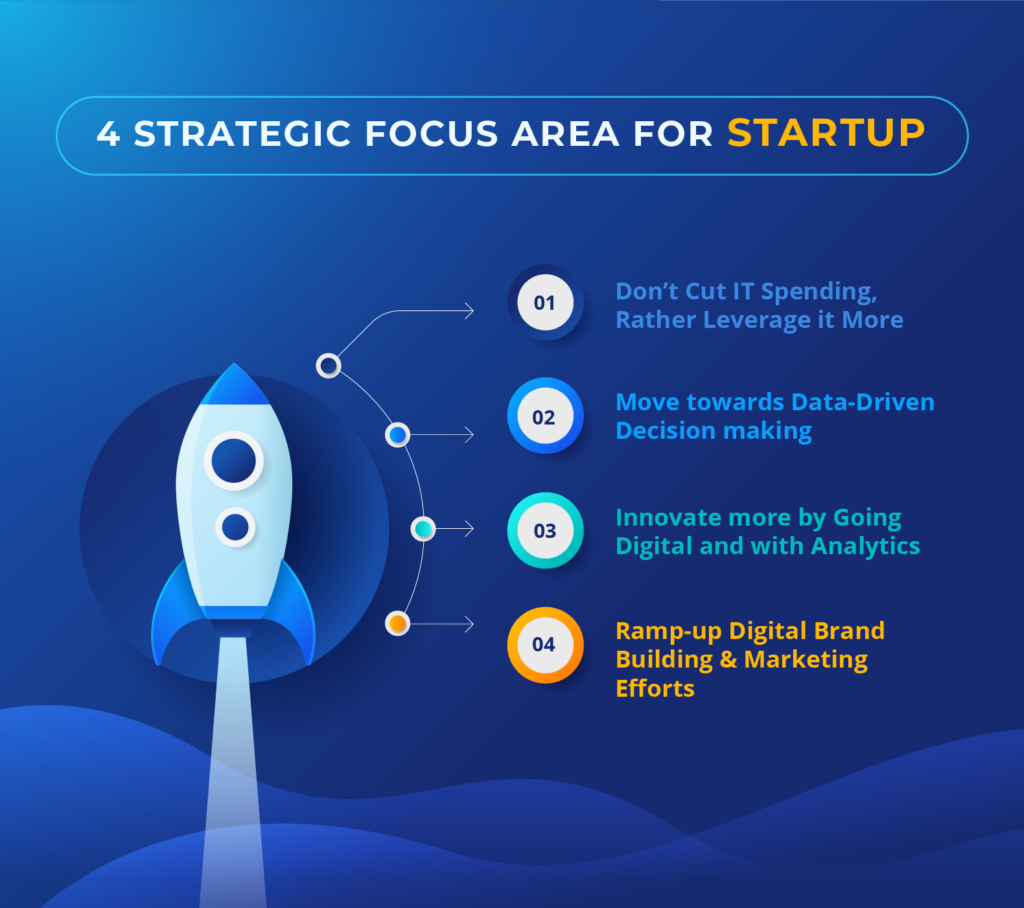During a downturn, a hostile business environment proves to be a stress-test for every organization. These exogenous macroeconomic shocks have proved to favour the well-prepared firms and are notorious for widening the performance gaps between the organizations.
In this article, we have examined the one critical factor which widens performance gaps between firms i.e. investment during a downturn, especially in IT, and explored how the decision may cause long-lasting competitive advantage and disadvantages.
In research by Havard professor Ranjay Gulati, on the impacts of the recession, he analyzed 4700 public companies and found that 9% of the companies come out of recession better than they went into, and outperform others by a significant margin.
The difference seems to be the level of preparedness and their response to the downturn that distinguishes the companies.
The knee-jerk reaction to recession is cost-cutting. Cut it quick, cut it deep, cut it ubiquitously, seems to be the mantra adopted by a significant number of companies and startups. Research done over decades indicates that cutting costs indiscriminately may do more damage than good. Discretion seems to be the sutra during these times. (Read More)
Those firms who prepare for the downturns, and are closely watching and responding to the changes in the business environment, selectively reducing costs and investing in future growth do a much better job. In this article, we postulate strategies that may go a long way in helping companies navigate a downturn.
But we would like to stress that the modern firm is quintessentially a digital firm, and technology is indubitably at the centre of every organizational strategy to combat a downturn.
- Don’t Cut IT Spending, Rather Leverage it More
- Towards Data-Driven Decision Making
- Innovate more by Going Digital
- Ramp-up Digital Brand Building & Marketing Efforts

- Don’t Cut IT Spending, Rather Leverage it More
Professor Pankaj Ghemawat, in his classic article “The risk of not investing in a Recession”, MIT Sloan Management Review, 2009, cautions that those firms who do not invest during a recession might incur far-reaching disadvantages that might eventually prove insurmountable.
In the present scenario, investment in IT during a downturn may seem counterintuitive but those who do shall reap big benefits. Recent data from other research finds that a portion of firms recruits highly skilled technology professionals during a recession, this seems to be motivated by easy availability, and the trend diminishes with economic recovery.
Economists profess that since the opportunity cost is lower, the resources are not as scarce as when the growth is high and every penny needs to be invested to support growth. For this reason,
Incorporating technological changes is less costly during the downturns than during boom.
On the other hand, crisis exposes various weaknesses of the business, and the incentive to improve is maximum as there is a willingness to change. Technology brings more transparency, agility, and efficiency. Going digital allows companies to harness the power of analytics to get a better understanding of business operations and other areas; exploring thus the areas of improvements.
Startups who are involved with so many things can consider a slowdown as a chance to invest in IT and derive vital competitive advantage from it, a luxury that would have been difficult to capture during the boom phase. As a result, the chunk of companies that increase digital transformation efforts may be creating long-lasting competitive advantages. Digital Transformation is the key to cost reduction during downturns; here is why:
- With falling revenues, employees can devote a little extra time to master process automation and new IT systems, thus improving the cost-effectiveness.
- Technology helps companies better exploit data for more informed decision making and explore the areas of process improvement.
- Technology investments go a long way in helping companies take advantage of emerging trends and gain market share.
- Digital Transformation efforts have a low success rate, only one-third succeed, an economic downturn is the most prudent move as companies can give time and attention to make it work.
A slowdown as a golden opportunity to invest in IT and derive vital competitive advantage from it, a luxury that would have been difficult to capture during the boom phase. Spending cuts on IT would be significantly damaging.
- Towards Data-Driven Decision Making
The decision-making paradox the modern agile organization faces today is- on the one hand, they want to be more agile, while, on the other, they also want to include all the right stakeholders in their processes. So, the present world dialogue has in a sense moved beyond the old monochromatic debates of “centralization/decentralization” for digital firms to data enable structures and decisions.
For the modern organization, the new issues revolve around the central question about decision rights and their transparency as they are the only mechanism to improve modern-day decision making.
The new realm debates on who has the right to access, process, and share data which is a treasure trove and the bone of contention, both.
In essence, big data and analytics are behind the new paradigm. Technology facilitates greater transparency which increases the real-time awareness of the situation. Ironically, the ability to act on new information is still subjective.
Customers want greater agility, and employees demand greater empowerment; is it possible to provide both? Yes.
As Thomas H. Davenport, world-renowned thought leader and author on AI and analytics, says organizations need to develop data-driven culture, only then can the decision making change. During downturns there are various vital areas companies can focus on to become better; investment is thus the most significant element.
- Innovate more by Going Digital
Any company, big or small, must empower their innovation process with emotional analytics. As every downturn is unique, it triggers different consumer emotions and behaviour. Every endeavour of an organization; Idea generation, Brand building, marketing campaigns, and more, can enormously benefit from the awareness of the latest consumer emotions.
Companies must deploy emotional analytics as pioneered by companies such as Happen, who exploit big-data to capture consumer responses and use it to facilitate better product and service designs. Responding to emotions is one of the most effective ways to grab the attention and loyalty of consumers.
Analysis of online conversations, unprovoked and genuine, is a treasure trove. The use of emojis and texts used for conversations makes the analysis of emotions feasible. When a recession hits, changes create opportunities for companies to respond with better solutions, and companies must use these nuggets of data to drive decisions. Big data for improving consumer experience and through data analytics.
- Ramp-up Digital Brand Building & Marketing Efforts
During the times of downturn, brand building and marketing activities are the ones first in the lines of those who are victims of cost-cutting. World’s leading brand leadership experts such as Denise Lee Yohn, vociferously advocate that startups or young companies can not afford to halt brand building activities, as it would send them years back after the recession is over. Startups need, she says, Minimum Viable Brands and downturns may prove to be a good time to make a mark.
Peter Drucker could not be more right when he said that “If you can’t measure it, you can’t manage it”. In branding, it’s even more significant, because the measurement is elusive, and the only through quantitative function it can be ascribed to is with Big data-powered analytics.
- The downturn may be the best time to drive cause and value-driven branding.
- Complete stoppage of branding activities will inflict more damage to the company in the long run
- Instead of cutting complete budgets, companies should think of selective IT-enabled niche branding efforts that are not only cost-effective but also communicate brand values.
Conclusion
Economic downturns are the most challenging phases for organizations. Startups, face falling demand and funding while consumer behaviour and preferences are changing. Though it appears counterintuitive, it is vital to invest during a downturn.
Companies must leverage the uncertainty of the market to push forward with changes. They must invest in new technologies, new organizational structures, and cultures to accommodate for the copious changes on the way and create space for long-lasting growth.
 All Posts
All Posts


